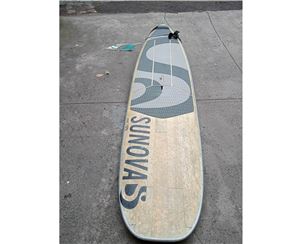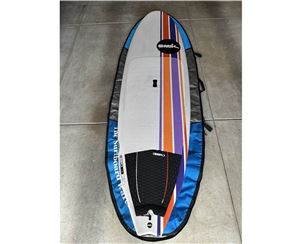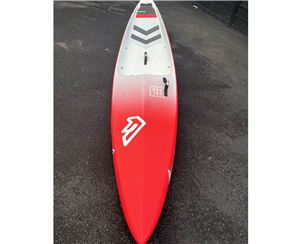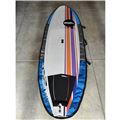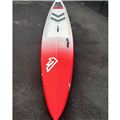What is Stand Up Paddle Surfing?
What is SUP?
SUP stands for Stand Up Paddle surfing.
 And, no prizes for working out that it entails Standing on a surfboard and Paddling yourself around. Stand Up Paddle surfboards are much longer, wider and more buoyant than 'normal' surfboards, enabling you to comfortably balance on them and propel yourself with the paddle.
And, no prizes for working out that it entails Standing on a surfboard and Paddling yourself around. Stand Up Paddle surfboards are much longer, wider and more buoyant than 'normal' surfboards, enabling you to comfortably balance on them and propel yourself with the paddle.
Aside from being another way of catching waves, SUP is also an increasingly popular way of keeping fit, and improving core-stability - flat water SUP trips, and 'down-winders' are both a great work out, and a good way to get on the water when the surf's junk, or it's flat - and a SUP session is definitely more fun than hitting the gym. In fact, with the cash you save on your gym membership, you'll be able to buy a new board (or maybe a fin) in a few months time: so a cash saver too!
Where does SUP come from?
Stand Up Paddle surfing (or SUP) is - depending on which way you look at it - either the newest or the oldest kid on the watersports block.
With roots that predate surfing as we know it, SUP has technically been around since ancient Polynesian times although - granted - it did have a 300 year or so hiatus. It was picked up again in the 60s by the Waikiki 'beach-boys' in Hawaii, who found the higher vantage point a better way to keep an eye on the pupils in their surf schools.
Modern materials can be thanked for SUP's most recent renaissance. The heavy redwood board of Polynesian Paddle Boards would probably be too heavy to even put on the top of your car, whereas modern Epoxy boards are light enough to be easily carried down to the beach, and can be more effectively manoeuvred once out on the water.
So, with modern materials (and knowledge transferred from the last 60 years of surfboard development), plus endorsements (and some pretty startling video footage) from some of surfing's genuine 'watermen' - this time round it seems that SUP is here to stay.
What can I do on my SUP?
Stand Up Paddle surfing is an incredibly versatile sport (another variable in its meteoric rise in popularity). You can take a look at the forecast and choose what you want to do with your SUP on any given day: and there won't be many days when you can't get out and do something.
 Surfing is the most technical form of Stand Up Paddleboarding, and the publication of pictures of Laird Hamilton and friends surfing 20+ foot waves in Hawaii stoked the imaginations of the new generation of SUPers. But it's not just extremely big waves that SUPs can deal with: you can also catch waves that are way too small for conventional surfing - or too 'messy'. The length of the board and the fact that it picks up waves earlier make it a real wave catching machine and, once caught, it's much easier to stay on the wave, making surfing 'poor' surf much more fun. It is this fact that is behind the increasing interest in SUP by regular surfers who can get on the waters much more often with a SUP in their quiver.
Surfing is the most technical form of Stand Up Paddleboarding, and the publication of pictures of Laird Hamilton and friends surfing 20+ foot waves in Hawaii stoked the imaginations of the new generation of SUPers. But it's not just extremely big waves that SUPs can deal with: you can also catch waves that are way too small for conventional surfing - or too 'messy'. The length of the board and the fact that it picks up waves earlier make it a real wave catching machine and, once caught, it's much easier to stay on the wave, making surfing 'poor' surf much more fun. It is this fact that is behind the increasing interest in SUP by regular surfers who can get on the waters much more often with a SUP in their quiver.
'Non surfing' paddleboarding options are extensive. Many landlocked SUPers use their boards to explore lakes and rivers - the higher vantage point being a plus over boats and kayaks. For those by the coast who don't want to surf, there are plenty of estuaries and harbours to be explored, or you can take on a down-winder: pick a windy day and just go with the flow! Whatever you're up to, you can cover more ground than you think on a SUP, and it is a great all-round workout.
I'm in! What do I need to get?
To get started, you'll need to choose yourself a board. SUP's growth in popularity has been matched by an increased number of board shapers and producers. There's now a bewildering number of boards available and - as with surfing - a plethora of different tail shapes and fin configurations too.

If you're just starting out, however, then you're probably best off sticking to the 'conventional' shapes of the main board producers. The key variable will be the length of the board you need. This depends to some extent on what you plan on doing with your new SUP - if you'll mainly be in the surf then you'll want a shorter board than if you are planning to spend most of your time on flat water. Assuming you're not sure how you'll be spending most of your SUP time, and want to be able to have a go at everything, your first board should be between 10'5" and 13' and between 30 and 34" wide. Within these ranges, your height and weight will dictate exactly which board you're best suited to.
Ok, so you thought you'd done the tough bit and got the right board. Afraid not: your paddle options are almost as many and varied as your board options... Thankfully, your paddle choice is mainly dictated by one variable: your budget! With the lightest and strongest carbon fibre paddles being the most expensive and plastic paddles the cheapest. In terms of the length of your paddle - it should be roundabout 6 inches taller than you. Some paddles are provided in one length and you will need to cut it down to the right length for your height.
The only other things you'll need to think about are Leash and Deckpad (a 'grip' that you stick on the top of your board). You'll definitely need a leash and a Deckpad is down to personal preference, with some SUPers preferring the authentic waxed board approach.
OK, and you're good to go!
Check the Stand Up Paddle Forums where you'll find heaps of crew ready to help you out with locations, gear and meeting others. There's no doubt that SUP's popularity will continue to increase and that it's here to stay this time round. Granted, it might be a few sessions before you're taking on any 10ft+ waves, but the great things about SUP is that you can go 100% at your own pace, and you're always improving: so just get out there, enjoy, and join the revolution!
Online Resources:
Don't wreak havoc in the lineup with your SUP! Read "Kook or Kool" - Your first go in the surf
(C) 2009 Seabreeze.com.au




